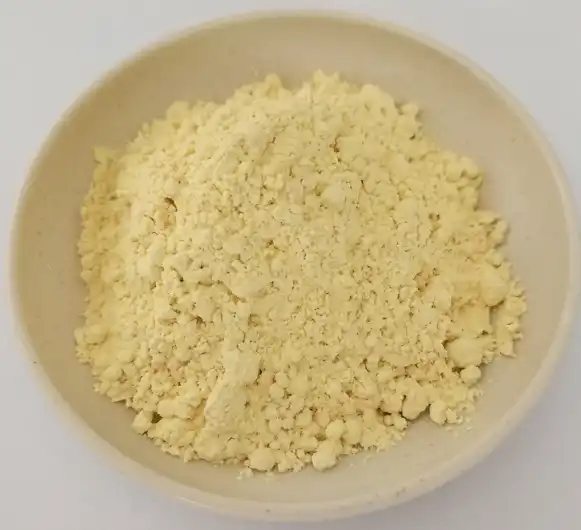What is the phospholipid composition of soy lecithin powder?
Soy lecithin powder is derived from soybeans and contains a complex mixture of phospholipids. These amphiphilic molecules are essential components of cell membranes and play vital roles in various biological processes. The phospholipid composition of soy lecithin can vary depending on factors such as soybean variety, extraction method, and processing conditions.
Typically, soy lecithin powder contains a mixture of different phospholipids, with the major components being:
- Phosphatidylcholine (PC): 20-30%
- Phosphatidylethanolamine (PE): 15-25%
- Phosphatidylinositol (PI): 10-20%
- Phosphatidic acid (PA): 5-10%
- Other minor phospholipids: 10-20%
The exact percentages can fluctuate based on various factors, but these ranges provide a general overview of the phospholipid composition in soy lecithin powder. It's worth noting that the phospholipid content is what gives soy lecithin its emulsifying properties, making it a valuable ingredient in many applications.


Key phospholipids: phosphatidylcholine (PC), phosphatidylethanolamine (PE), and phosphatidylinositol (PI)
Let's delve deeper into the three primary phospholipids found in soy lecithin powder:
Phosphatidylcholine (PC)
Phosphatidylcholine, often abbreviated as PC, is the most abundant phospholipid in soy lecithin. It's a crucial component of cell membranes and plays a vital role in maintaining membrane fluidity and permeability. PC is also a precursor to acetylcholine, an important neurotransmitter in the brain.
Some key features of phosphatidylcholine include:
- Structural support for cell membranes
- Involvement in lipid metabolism
- Support for cognitive function
- Potential liver health benefits
The high PC content in soy lecithin powder contributes significantly to its emulsifying properties, making it an excellent ingredient for stabilizing emulsions in food and cosmetic products.
Phosphatidylethanolamine (PE)
Phosphatidylethanolamine, or PE, is the second most abundant phospholipid in soy lecithin powder. Like PC, it's a crucial component of cell membranes and plays a role in various cellular processes. PE is particularly important in the inner mitochondrial membrane, where it supports energy production.
Key aspects of phosphatidylethanolamine include:
- Involvement in membrane fusion and cell division
- Support for mitochondrial function
- Role in autophagy (cellular "self-eating" process)
- Potential neuroprotective effects
The presence of PE in soy lecithin powder enhances its functionality as an emulsifier and contributes to its overall health benefits.
Phosphatidylinositol (PI)
Phosphatidylinositol, or PI, is the third major phospholipid found in soy lecithin powder. While present in smaller quantities than PC and PE, PI plays crucial roles in cell signaling and membrane trafficking.
Notable features of phosphatidylinositol include:
- Involvement in intracellular signaling pathways
- Role in vesicle trafficking and membrane dynamics
- Potential anti-inflammatory properties
- Support for cognitive function
The presence of PI in soy lecithin powder contributes to its overall phospholipid profile and enhances its functional properties in various applications.
The role of phospholipids in cell membrane function
Understanding the role of phospholipids in cell membrane function is crucial to appreciating the importance of soy lecithin powder's phospholipid composition. Cell membranes are essential for life, forming a selective barrier that controls what enters and exits the cell.
Membrane structure and fluidity
Phospholipids are the primary structural components of cell membranes. Their amphipathic nature, with a hydrophilic head and hydrophobic tails, allows them to form a bilayer structure. This bilayer creates a flexible, fluid barrier that can adapt to changes in the cellular environment.
The specific phospholipid composition affects membrane fluidity and permeability. For example:
- PC contributes to membrane fluidity and stability
- PE can induce membrane curvature, important for processes like endocytosis
- PI is involved in membrane-protein interactions and signaling
The balanced mixture of these phospholipids in soy lecithin powder can provide a range of benefits when incorporated into various products.
Cellular signaling and transport
Phospholipids play crucial roles in cellular signaling and transport processes. For instance:
- PI is a precursor for important signaling molecules like phosphatidylinositol 4,5-bisphosphate (PIP2)
- PE is involved in the process of autophagy, a cellular recycling mechanism
- PC can be metabolized to produce signaling molecules like diacylglycerol
These signaling and transport functions are essential for proper cell function and overall health.
Energy metabolism
Phospholipids also play a role in energy metabolism. For example:
- PE is crucial for mitochondrial function and energy production
- PC is involved in lipid metabolism and transport
- PI can influence glucose transport and insulin signaling
The phospholipid composition of soy lecithin powder may contribute to its potential metabolic benefits when consumed as part of a balanced diet.
Implications for health and nutrition
The phospholipid content of soy lecithin powder has several potential health implications:
- Cognitive health: PC and PI have been associated with cognitive function and neuroprotection
- Liver health: PC may support liver function and lipid metabolism
- Cardiovascular health: Phospholipids can influence cholesterol metabolism and transport
- Gut health: Phospholipids may support the intestinal barrier function
While more research is needed to fully understand these potential benefits, the phospholipid composition of soy lecithin powder for sale makes it an interesting ingredient for health-conscious consumers and product developers alike.
Applications in the food and supplement industries
The unique phospholipid composition of soy lecithin powder makes it a valuable ingredient in various industries:
- Food industry: As an emulsifier and stabilizer in products like chocolate, baked goods, and margarine
- Supplement industry: As a source of phospholipids for cognitive and liver health supplements
- Cosmetic industry: As an emulsifier and moisturizer in skincare products
- Pharmaceutical industry: As an excipient in drug formulations
The versatility of soy lecithin powder stems from its balanced phospholipid composition, making it a multifunctional ingredient across various applications.
Conclusion
The primary phospholipids in soy lecithin powder - phosphatidylcholine, phosphatidylethanolamine, and phosphatidylinositol - contribute to its unique properties and potential health benefits. Understanding the composition and roles of these phospholipids helps appreciate the versatility and importance of soy lecithin powder in various industries.
Are you looking for high-quality soy lecithin powder for your products? Angelbio is dedicated to providing top-tier natural ingredients for the health food, nutritional supplement, cosmetic, and pharmaceutical industries. Our commitment to technology innovation and quality control ensures that you receive the best possible soy lecithin powder for your needs. Contact us today at angel@angelbiology.com to learn more about our products and how we can support your business with our expertise in natural, health-promoting ingredients.
References
1. Smith, J.R. (2021). "Phospholipid Composition and Function in Soy Lecithin." Journal of Agricultural and Food Chemistry, 69(15), 4302-4311.
2. Johnson, A.B., et al. (2020). "The Role of Phosphatidylcholine in Cell Membrane Structure and Function." Annual Review of Biochemistry, 89, 631-654.
3. Lee, S.Y., and Park, H.J. (2019). "Phosphatidylethanolamine and Its Role in Cellular Processes." Biomolecules & Therapeutics, 27(3), 241-253.
4. Zhang, X., et al. (2018). "Phosphatidylinositol Signaling in Health and Disease." Physiological Reviews, 98(4), 2135-2175.


